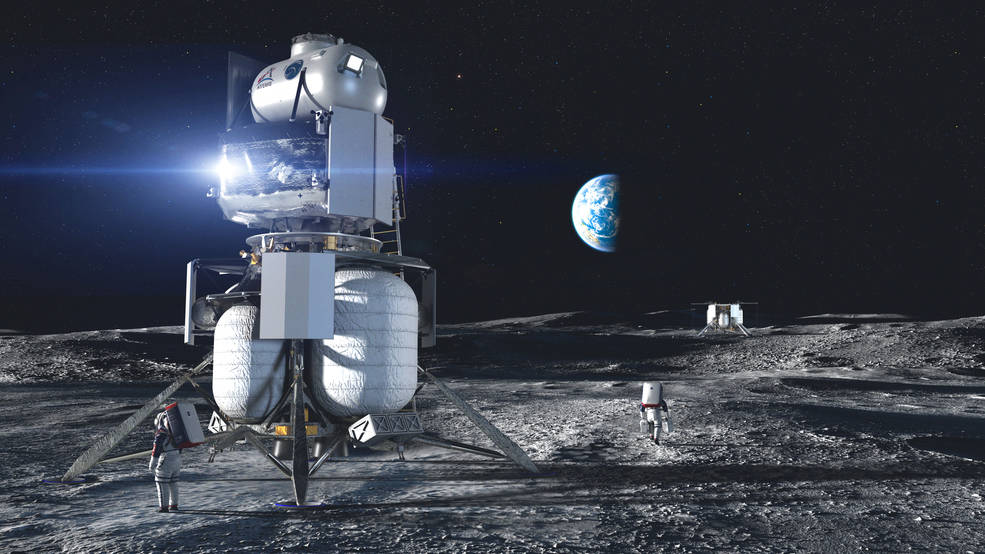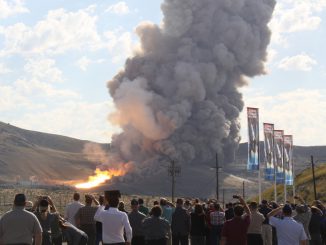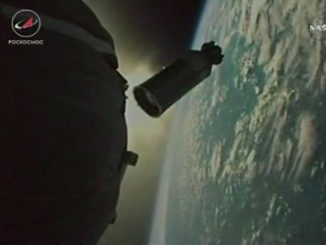
House lawmakers this week proposed to fund NASA’s human-rated lunar lander development program at less than one-fifth of the level the Trump administration wanted, but NASA Administrator Jim Bridenstine said Wednesday the House budget bill is just the “opening salvo” in an appropriations process that now goes to the Senate.
The appropriations bill in the House of Representatives would approve $22.63 billion for the space agency in fiscal year 2021, the same budget NASA received for fiscal year 2020. The figure falls short of the Trump administration’s request of $25.246 billion for NASA next year.
The difference in the House budget and the White House’s proposed spending plan is largely in NASA’s Artemis program, which aims to land the first woman and the next man on the moon before the end of 2024.
The White House asked Congress for $8.761 billion for deep space exploration systems development in 2021, including work on the Space Launch System heavy-lift rocket, Orion crew capsule, human-rated lunar landers, and the Gateway mini-space station to be assembled in orbit around the moon. The bill released earlier this week by the Commerce, Justice and Science Subcommittee of the House Appropriations Committee would provide $6.017 billion for work on future crewed missions to the moon.
The bill drafted by the House appropriations subcommittee would provide $628.2 million for NASA’s Human Landing System program, in which the space agency is partnering with private industry to develop commercial spacecraft to ferry astronauts to and from the lunar surface. In the White House budget request in February, NASA asked Congress for nearly $3.37 billion for the human-rated moon lander program.
In a statement, Bridenstine thanked the House appropriations subcommittee for the “bipartisan support they have shown NASA’s Artemis program.”
“The $628.2 million in funding for the Human Landing System (HLS) is an important first step in this year’s appropriations process,” Bridenstine said in a written statement. “We still have more to do and I look forward to working with the Senate to ensure America has the resources to land the first woman and the next man on the moon in 2024.”
NASA announced contracts with three industrial teams in April to advance concepts for a Human Landing System.
A team led by Blue Origin — with participation from Lockheed Martin, Northrop Grumman and Draper — won a $579 million contract. Dynetics and SpaceX received deals worth $253 million and $135 million, respectively.
The three teams began 10-month design and concept maturation studies, and NASA officials previously said they were likely to down-select to two lander proposals to continue into full development. But those plans hinge on how much Congress appropriates for the Human Landing System program.

Congress approved $600 million for the HLS program in fiscal year 2020, the most significant funding for a NASA human-rated moon lander since the Apollo program.
“This is the opening salvo from the House of Representatives, which is controlled by Democrats, and they have (more than) $600 million in the bill for a Human Landing System,” Bridenstine said Wednesday in remarks during NASA’s Exploration Science Forum. “Now that’s not everything we asked for, but what it shows is there’s bipartisan support for this activity, and we can work with the Senate to help get more resources as is necessary to achieve the 2024 landing.”
The Republican-led Senate has been more receptive to the Artemis moon landing program. Vice President Mike Pence announced the 2024 target for the next crewed lunar landing in March 2019.
Appropriators in the Senate have not yet released their version of the NASA budget for 2021. NASA’s budget is bundled in a spending bill shared with other federal agencies, including the Department of Commerce and the Department of Justice.
Once each chamber passes the Commerce, Justice and Science appropriations bill, lawmakers will try to iron out the differences before voting on a final version to be sent to the White House for President Trump’s signature.
In May, members of the NASA Advisory Council’s Human Exploration and Operations committee expressed doubt that NASA could pull off a human landing on the moon by the end of 2024.
Tommy Holloway, a former space shuttle and space station program at NASA, called the aggressive schedule to develop a Human Landing System in a little more than four years a “pipe dream.”
“There’s no way that they’re going to get there,” Holloway said.
Jim Voss, a retired NASA astronaut, said the program appeared to be “marking time” with its pursuit of trade studies to guide decision-making on the Artemis architecture.
“I don’t think they have any chance of making 2024, and we can argue about that all day, but they won’t make 2028 if we keep restudying everything,” Voss said in May.
Before Vice President Pence announced the 2024 schedule objective last year, NASA was aiming to return humans to the lunar surface by 2028. Bridenstine argued Wednesday that setting 2024 as the goal was beneficial.
“2024 matters because, number one, it drives the budgets that we need to achieve these goals, and number two, the longer the programs go and the more expensive they become, the more likely they are to get canceled, and we’ve seen that over and over again,” Bridenstine said. “We need to put points on the board, and once we get there we need to grow. Driving down costs, increasing access, reusability, all of these things need to be driven into the architecture.”
The House appropriations subcommittee charged with helping write NASA’s budget proposed providing $2.6 billion for the Space Launch System in 2021, well above the White House’s request for $2.257 billion. The House bill calls for $1.4 billion for the Orion crew capsule program next year, the same level of funding NASA proposed.
The budget bill would provide $459.7 million for exploration ground systems next year, including infrastructure at the Kennedy Space Center in Florida to support SLS/Orion launches. That’s an increase over the $384.7 funding line in the White House budget request.
The House spending proposal includes $4.052 billion for low Earth orbit space operations, encompassing the International Space Station program and funding to pay for commercial crew and cargo transportation services. The Trump administration asked for $4.187 billion.
There’s $1.1 billion in the House bill for space technology development, down from $1.578 billion in the White House proposal. The House plan calls for nearly $7.1 billion for NASA’s science mission directorate in 2021, nearly $800 million more than the Trump administration requested.
NASA would get $819 million for its aeronautics programs in 2021 under the House version of the budget, in line with the White House request. The House bill also provides $126 million for NASA’s education program, which was planned to be eliminated by the Trump administration.
The House bill would appropriate more than $2.9 billion for NASA’s safety, security and mission services, $419 million for construction and environmental compliance and restoration, and $44.2 million for the office of the inspector general.
Email the author.
Follow Stephen Clark on Twitter: @StephenClark1.



